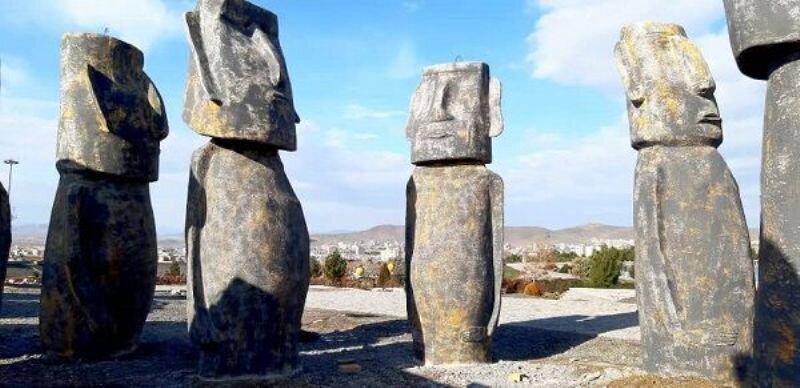Replicas of Easter Island’s moais on show in Iran

TEHRAN – A total of ten replicas of Easter Island’s moai statues have been constructed and installed in a theme park in Malayer, western Iran.
These statues with an average height of three meters were built using metal frames covered by concrete slabs that have been painted in terms of showing the texture and colors of the gray and black of the sculptures, Malayer Mayor Hossein Babaei said on Wednesday, IRNA reported.
The Eiffel Tower, Si-o-Se Pol (Bridge of Thirty-Three Arches), the Hafez mausoleum, the Leaning Tower of Pisa, and some Achaemenian-era sites are amongst tens of monuments one can see within the theme park in western Iran. As a window to the world, the theme park is estimated to lure more travelers to Malayer, which has earned a national reputation for its rugs and popular parks.
Easter Island, the most remote inhabited island on the planet, is 3,700 kilometers from the coast of continental Chile and has an area of 16,628 hectares while the World Heritage property occupies an area of approximately seven thousand hectares, including four nearby islets.
Rapa Nui National Park is a protected Chilean wildlife area located in Easter Island, which concentrates on the legacy of the Rapa Nui culture. This culture displayed extraordinary characteristics that are expressed in singular architecture and sculpture within the Polynesian context.
From the 10th to the 16th century this society built shrines and erected enormous stone figures known as moai, which created an unrivaled cultural landscape that continues to fascinate people throughout the world.
A hub of woodcarving
Malayer may be top on the list for those who are interested to visit a woodcarving hub. The west-central Iranian town is named a global hub for woodcarving and carved-wood furniture by the World Crafts Council - Asia Pacific Region (WCC-APR).
Located in Hamedan province, the ancient city is home to over 4,000 furniture workshops in which more than 8,000 wood masters and some 25,000 crafters are engaged.
Although the art had been practiced in Malayer for a long time ago, it is about a half-century that it has gained prosperity in the region. In some cases, the whole family is occupied with traditional furniture making and although they didn't make much money this way, their love for handicrafts and the increasing perseverance of woodcarving artists of Malayer shows today a new face of this art-craft to the world.
Artists and crafter of this region use the wood of beech, walnut, and plane trees to make different products such as traditional, classic, steel, and sofa furniture. Their other products are dining table, desk, all kinds of chair, bed and decorative pieces.
Currently, some 60 percent of the furniture and woodcarving products in Iran are reportedly produced in Malayer and they are sent to various Iranian cities or being exported to Central Asian countries, Persian Gulf littoral states, Turkey, and Iraq amongst some others. Known in classical times as Ecbatana, Hamedan was one of the ancient world’s greatest cities. Pitifully little remains from antiquity, but significant parts of the city center are given over to excavations, and there’s a scattering of historical curiosities.
AFM/
